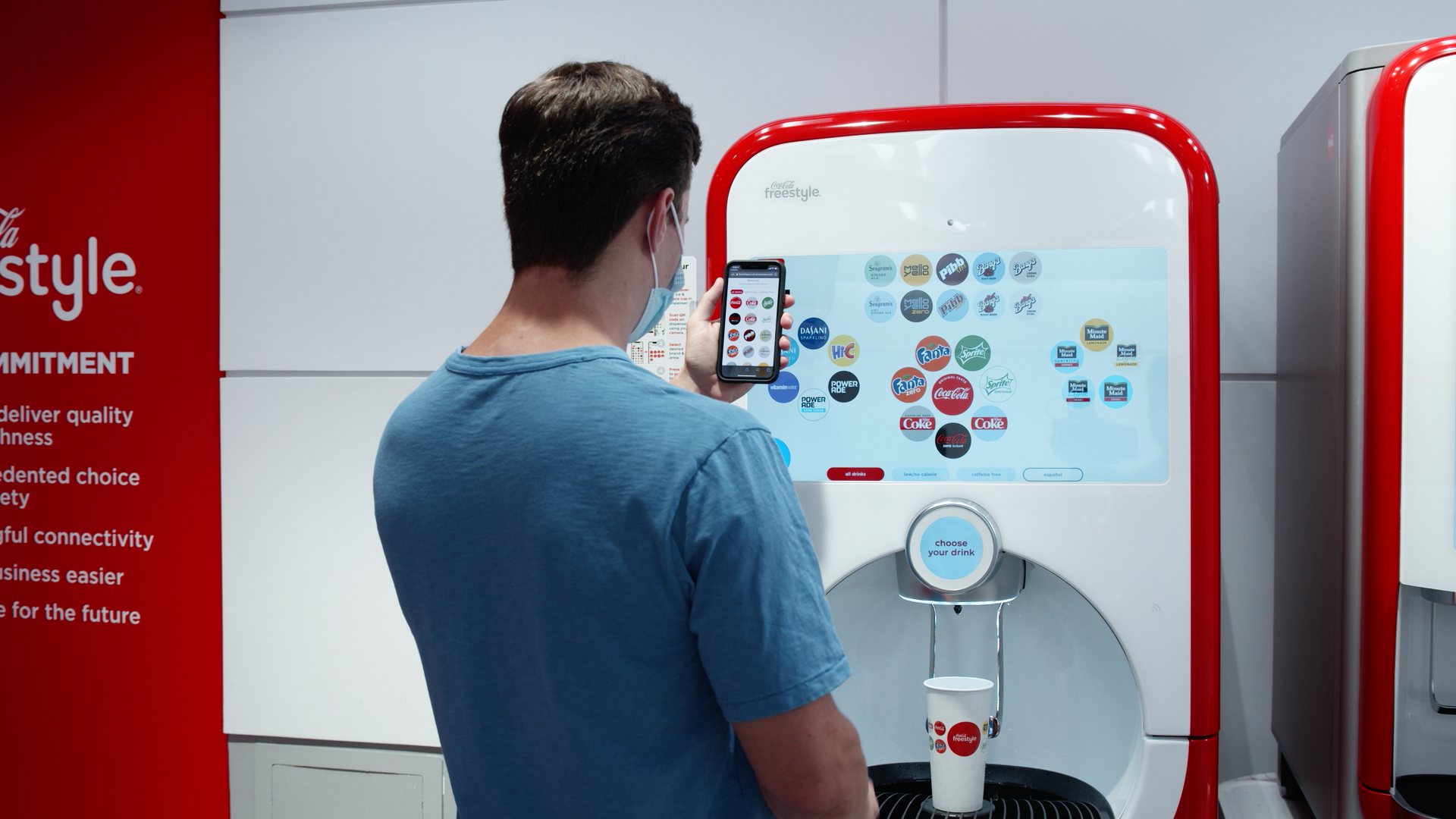 CLOUD
CLOUD
 CLOUD
CLOUD
 CLOUD
CLOUD
Coca-Cola Co. and cloud computing platform Amazon Web Services Inc. joined forces recently to rethink how people get fountain drinks amid the global pandemic caused by COVID-19.
When people get food at restaurants, it’s no longer the casual experience of a mere eight months ago when people could breeze in through the door, order food at the counter, pick up a tray and sit down. Now it involves donning a mask, standing six feet apart from other people and avoiding as much physical contact as possible.
Coca-Cola wanted to help automate the dispensation of its products inside restaurants to match this expectation, and it turned to AWS.
It meant upgrading Cocoa-Cola Freestyle kiosks, which were already touchscreen drink dispensers, to allow customers to use their smartphones to select drinks from them without ever having to touch the machine at any point other than to set the cup down — even then only the cup touches the machine.
“We’re investing a lot of time to understand how consumer behaviors are evolving throughout the pandemic and making sure our tech strategy matches those and future behaviors,” said Thomas Stubbs, vice president of Engineering and Innovation at Coca-Cola Freestyle. “While all Coca-Cola beverage dispensers are safe with recommended care and cleaning, we acted quickly when the pandemic hit to reimagine the future of the Freestyle machine and get ahead of shifting consumer needs.”
The Freestyle machine, available in 17 countries, can dispense more than 200 different Coca-Cola beverage options. Users may also select from mixtures of flavors of different products, such as Strawberry Sprite combined with Fuze Tea, which are then individually dispensed.
In order to make the experience entirely contactless, the Coca-Cola Freestyle team joined with AWS to get a back-end infrastructure built that would allow customers to use their smartphones to activate the machine.
As soon as the pandemic hit, the team was able to develop, test and deploy the software code to the machines – all mostly working remotely – in under 100 days after the initial concept was complete. AWS co-designed the architecture and that helped design and prototype the final solution.
Essentially, the idea was to migrate the user experience of having the interface of the Freestyle machine onto the user’s phone. It requires no app to download or account to sign into. Users need only scan a QR code displayed on the Freestyle machine’s UI and they’re good to go. The rest of the challenge takes place entirely behind the scenes in the AWS cloud.
“You can think of what happens behind the scenes in terms of event-driven architecture,” Peder Ulander, director of Marketing for Serverless, Open Source and Containers at AWS, told SiliconANGLE in an interview. “When someone enters a room, they can flip a light switch or the room recognizes someone’s here, turns the light on and when they leave, turn the light off with no human intervention required. It basically takes stock of the state of the room and takes an action based on that.”
This is essentially how developers are building on top of Amazon Lambda, a serverless architecture provided by AWS to run the cloud-based on-demand application architecture that acts provides the service for the Freestyle machine interface on the smartphones.
“In the case of Coca-Cola, what they’re doing here is a number of different things working behind the scenes to make this happen,” said Ulander. “First off, a QR code going to the phone basically triggers that first event. The user standing in front of this specific machine interested in pouring a beverage and what happens is it links together a web interface on the customer’s phone, calls up the Amazon Lambda resources on the back-end to do the processing, gets the beverage selection from the customer, pours the correct amount into the customer’s cup at that machine and finally resets the machine for the next customer after a timeout.”
All of this must come together in real-time and do so at high enough bandwidth and fidelity to process the just-in-time for tens of thousands of “internet of things” devices, which is where AWS’ high-resiliency cloud comes into play, Ulander said.
Currently more than 25,000 machines have this touchless capability and, by the end of 2020, all Freestyle machines in the U.S. will be touchless. Coca-Cola expects to have worldwide deployment to follow shortly thereafter.
Both Coca-Cola and AWS believe this is an important step toward making the restaurant industry safer for customers going forward in a post-COVID-19 world given the ongoing nature of the global pandemic. As CDC guidelines suggest that people wear masks, maintain social distance with other people, avoid unnecessary contact with objects and wash our hands often, this sort of advance in technology will make visiting a restaurant a quicker, safer experience – which also means less potential exposure for customers and workers.
Additionally, this sort of intuitive concept could become a touchstone for other product uses since smartphones are a near-ubiquitous interface carried by a multitude of customers. That opens up numerous opportunities.
“This innovation is the epitome of customer obsession – using evolving consumer expectations as inspiration for an even better experience,” said David Ahuja, head of worldwide consumer packaged goods at AWS. “Coca-Cola Freestyle is paving the way for touchless experiences across other industries. With touchpads in our pockets, just think of all the ways we can improve upon today’s contact-based machines, such as the ATMs and elevators, as well as items such as restaurant menus that can all be operated through smartphones.”
THANK YOU